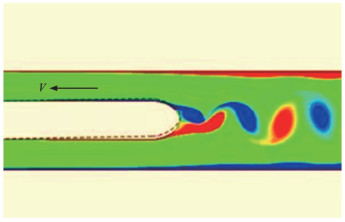Mechanism of train tail lateral sway of EMUs in tunnel based on vortex-induced vibration
Article Text (Baidu Translation)
-
摘要: 针对时速160 km动车组在单线隧道内列尾横向晃动问题,提出列尾气流涡脱效应引起车体涡激振动而导致列尾横向晃动的机理,研究了车辆悬挂参数改进等相关抑制措施;根据某动力车结构参数,建立车辆横向动力学模型,结合半经验非线性涡激振子模型,实现涡激振动时车辆流固耦合横向动力学计算。计算结果表明:单线隧道内动车组列尾较大的横向涡激力以及涡激频率与车体蛇行频率共振是引起晃车的主要原因;减小横向涡激力、提高车辆蛇行运动稳定性是减小晃车幅值的有效措施;针对该动力车,需避免较低等效锥度的轮轨接触,以防车辆一次蛇行导致涡激振动加剧;当转向架抗蛇行减振器阻尼由800 kN·s·m-1减小到400 kN·s·m-1,涡激共振时车体后端横向振动加速度幅值减小40%;车辆二系横向悬挂采用天棚阻尼半主动控制时,可以有效减小涡激共振区车体横向振动幅值,并能兼顾车体前后端横向平稳性。Abstract: Aiming at the train tail lateral sway of 160 km·h-1 electric multiple units (EMUs), which occurs in single-track tunnels, the mechanism was put forward that the vortex shedding effect of gas flow in the train tail causes the vortex-induced vibration of the car-body and results in the lateral sway of the train tail. Relevant mitigation measures, such as the optimization of vehicle suspension parameters, were studied. Based on the structural parameters of a certain type of locomotive, the vehicle lateral dynamics model was established and combined with the semi-empirical nonlinear vortex-induced vibrator model to enable the fluid-solid coupling lateral dynamics calculation during the vortex-induced vibration. Calculation results show that a large lateral vortex-induced force acting on the train tail of EMUs in a single-track tunnel and the resonance between the vortex-induced frequency and the car-body hunting frequency are the main causes of car-body sway. Reducing the lateral vortex-induced force and improving the vehicle hunting stability are effective measures to reduce the amplitude of the car-body sway. For this type of locomotive, avoiding wheel-rail contact with a lower equivalent conicity is required to prevent aggravation of the vortex-induced vibration by vehicle primary hunting behavior. When the damping of the yaw damper is reduced from 800 kN·s·m-1 to 400 kN·s·m-1, the lateral vibration acceleration amplitude in the rear end of the car-body during vortex-induced resonance is reduced by 40%. When the semi-active control with skyhook damping in the secondary lateral suspension is adopted, the lateral vibration amplitude of the car-body in the vortex-induced resonance zone is effectively reduced. Moreover, the lateral ride comfort at the front and rear ends of the car-body can be guaranteed. 1 tab, 9 figs, 29 refs.
-
Key words:
- EMUs /
- lateral dynamics /
- vortex-induced vibration /
- fluid-solid coupling /
- suspension parameters
-
表 1 模型部分参数
Table 1. Model partial parameters
符号 数值 说明 V/(km·h-1) 160 速度 λ 0.1 轮轨接触等效锥度 ε 0.5 非线性自限气动阻尼系数 η 10 加速度反馈系数 KL0 0.4 静态涡激力系数 csx/(kN·s·m-1) 800 抗蛇行减振器阻尼 csy/(kN·s·m-1) 25 二系横向减振器阻尼 -
[1] 机车车辆研究所. 时速160公里动力集中电动车组(鼓形车体)过隧道尾车晃车问题分析报告[R]. 北京: 中国铁道科学研究院集团有限公司, 2020.Locomotive and Car Research Institute. The lateral sway of the train tail of the 160 km/h power centralized EMU (drum-shaped car body) passing through the tunnel[R]. Beijing: China Academy of Railway Sciences Corporation Limited, 2020. (in Chinese) [2] 马伟斌, 张千里, 刘艳青. 中国高速铁路隧道气动效应研究进展[J]. 交通运输工程学报, 2012, 12(4): 25-32. http://jtysgcxb.xml-journal.net/article/id/201204004MA Wei-bin, ZHANG Qian-li, LIU Yan-qing. Study evolvement of high-speed railway tunnel aerodynamic effect in China[J]. Journal of Traffic and Transportation Engineering, 2012, 12(4): 25-32. (in Chinese) http://jtysgcxb.xml-journal.net/article/id/201204004 [3] 肖京平, 黄志祥, 陈立. 高速列车空气动力学研究技术综述[J]. 力学与实践, 2013, 35(2): 1-12. https://www.cnki.com.cn/Article/CJFDTOTAL-LXYS201302000.htmXIAO Jing-ping, HUANG Zhi-xiang, CHEN Li. Review of aerodynamic investigations for high speed train[J]. Mechanics in Engineering, 2013, 35(2): 1-12. (in Chinese) https://www.cnki.com.cn/Article/CJFDTOTAL-LXYS201302000.htm [4] 李田, 戴志远, 刘加利, 等. 中国高速列车气动减阻优化综述[J]. 交通运输工程学报, 2021, 21(1): 59-80. doi: 10.19818/j.cnki.1671-1637.2021.01.003LI Tian, DAI Zhi-yuan, LIU Jia-li, et al. Review on aerodynamic drag reduction optimization on high-speed trains in China[J]. Journal of Traffic and Transportation Engineering, 2021, 21(1): 59-80. (in Chinese) doi: 10.19818/j.cnki.1671-1637.2021.01.003 [5] 李田. 高速列车流固耦合计算方法及动力学性能研究[D]. 成都: 西南交通大学, 2012.LI Tian. Approaches and dynamic performances of high-speed train fluid-structure[D]. Chengdu: Southwest Jiaotong University, 2012. (in Chinese) [6] 崔涛, 张卫华, 孙帮成. 高速列车流固耦合振动的研究方法及其应用[J]. 铁道学报, 2013, 35(4): 16-22. https://www.cnki.com.cn/Article/CJFDTOTAL-TDXB201304004.htmCUI Tao, ZHANG Wei-hua, SUN Bang-cheng. Research method and application of fluid-solid coupling vibration for high-speed train[J]. Journal of the China Railway Society, 2013, 35(4): 16-22. (in Chinese) https://www.cnki.com.cn/Article/CJFDTOTAL-TDXB201304004.htm [7] SUZUKI M, TANEMOTO K, MAEDA T. Aerodynamic characteristics of train/vehicles under cross winds[J]. Journal of Wind Engineering and Industrial Aerodynamics, 2003, 91(1): 209-218. [8] DIEDRICHS B, SIMA M, ORELLANO A, et al. Crosswind stability of a high-speed train on a high embankment[J]. Journal of Rail and Rapid Transit, 2007, 221(2): 205-225. doi: 10.1243/0954409JRRT126 [9] HEMIDA H, BAKER C. Large-eddy simulation of the flow around a freight wagon subjected to a cross wind[J]. Computers and Fluids, 2010, 39(10): 1944-1956. doi: 10.1016/j.compfluid.2010.06.026 [10] BAKER C J. The simulation of unsteady aerodynamic cross wind forces on trains[J]. Journal of Wind Engineering and Industrial Aerodynamics, 2010, 98(2): 88-99. doi: 10.1016/j.jweia.2009.09.006 [11] 田红旗. 中国高速轨道交通空气动力学研究进展及发展思考[J]. 中国工程科学, 2015, 17(4): 30-41.TIAN Hong-qi. Development of research on aerodynamics of high-speed rails in China[J]. Engineering Sciences, 2015, 17(4): 30-41. (in Chinese) [12] HEMIDA H, KRAJNOVIC S. Exploring flow structures around a simplified ICE2 train subjected to a 30 side wind using LES[J]. Journal of Engineering Applications of Computational Fluid Dynamics, 2009, 3(1): 28-41. [13] HEMIDA H. Large-eddy simulation of the flow around simplified high-speed trains under side wind conditions[D]. Gothenburg: Chalmers University of Technology, 2006. [14] DIEDRICHS B, KRAJNOVI AC'G S, BERG M. On the aerodynamics of car body vibrations of high-speed trains cruising inside tunnels[J]. Engineering Applications of Computational Fluid Mechanics, 2008, 2(1): 51-75. [15] GAO Z Y, TIAN B, WU D P, et al. Study on semi-active control of running stability in the high-speed train under unsteady aerodynamic loads and track excitation[J]. Vehicle System Dynamics, 2021, 59(1): 101-114. [16] 许福友, 丁威, 姜峰, 等. 大跨度桥梁涡激振动研究进展与展望[J]. 振动与冲击, 2010, 29(10): 40-49. https://www.cnki.com.cn/Article/CJFDTOTAL-ZDCJ201010011.htmXU Fu-you, DING Wei, JIANG Feng, et al. Research progress and prospects of vortex-induced vibration of long- span bridges[J]. Journal of Vibration and Shock, 2010, 29(10): 40-49. (in Chinese) https://www.cnki.com.cn/Article/CJFDTOTAL-ZDCJ201010011.htm [17] CHEN D Y, MARZOCCA P, XIAO Q, et al. Vortex-induced vibration on a low mass ratio cylinder with a nonlinear dissipative oscillator at moderate Reynolds number[J]. Journal of Fluids and Structures, 2020, 99: 101360. [18] RULLI F, BARBATO A, FONTANESI S, et al. Large eddy simulation analysis of the turbulent flow in an optically accessible internal combustion engine using the overset mesh technique[J]. International Journal of Engine Research, 2021, 22(5): 1440-1456. [19] 万德成, 端木玉. 深海细长柔性立管涡激振动数值分析方法研究进展[J]. 力学季刊, 2017, 38(6): 179-196. https://www.cnki.com.cn/Article/CJFDTOTAL-SHLX201702001.htmWAN De-cheng, DUANMU Yu. A recent review of numerical studies on vortex-induced vibrations of long slender flexible risers in deep sea[J]. Chinese Quarterly of Mechanics, 2017, 38(6): 179-196. (in Chinese) https://www.cnki.com.cn/Article/CJFDTOTAL-SHLX201702001.htm [20] 杨国伟, 魏宇杰, 赵桂林, 等. 高速列车的关键力学问题[J]. 力学进展, 2015, 45(7): 217-461. https://www.cnki.com.cn/Article/CJFDTOTAL-LXJZ201500007.htmYANG Guo-wei, WEI Yu-jie, ZHAO Gui-lin, et al. Key mechanics of high-speed trains[J]. Advances in Mechanics, 2015, 45(7): 217-461. (in Chinese) https://www.cnki.com.cn/Article/CJFDTOTAL-LXJZ201500007.htm [21] 张伟伟, 豆子皓, 李新淘, 等. 桥梁若干流致振动与卡门涡街[J]. 空气动力学学报, 2020, 38(3): 405-412. https://www.cnki.com.cn/Article/CJFDTOTAL-KQDX202003001.htmZHANG Wei-wei, DOU Zi-hao, LI Xin-tao, et al. Various flow-induced vibrations of bridges and von Karman vortex street[J]. Acta Aerodynamica Sinica, 2020, 38(3): 405-412. (in Chinese) https://www.cnki.com.cn/Article/CJFDTOTAL-KQDX202003001.htm [22] 睢娟. 大质量-阻尼圆柱涡激振动及其抑制的试验研究[D]. 上海: 上海交通大学, 2016.SUI Juan. Experimental study on VIV and its suppression of large mass-damping cylinder[D]. Shanghai: Shanghai Jiaotong University, 2016. (in Chinese) [23] 宋芳, 林黎明, 凌国灿. 圆柱涡激振动的结构-尾流振子耦合模型研究[J]. 力学学报, 2010, 42(3): 357-365. https://www.cnki.com.cn/Article/CJFDTOTAL-LXXB201003005.htmSONG Fang, LIN Li-ming, LING Guo-can. The study of vortex-induced vibrations by computation using coupling model of structure and wake oscillator[J]. Chinese Journal of Theoretical and Applied Mechanics, 2010, 42(3): 357-365. (in Chinese) https://www.cnki.com.cn/Article/CJFDTOTAL-LXXB201003005.htm [24] HOPPMANN U, KOENIG S, TIELKES T, et al. A short-term strong wind prediction model for railway application: design and verification[J]. Journal of Wind Engineering and Industrial Aerodynamics, 2002, 90(10): 1127-1134. [25] 潘永琛, 姚建伟, 刘涛. 基于涡旋识别方法的高速列车尾涡结构的讨论[J]. 力学学报, 2018, 50(3): 667-676. https://www.cnki.com.cn/Article/CJFDTOTAL-LXXB201803022.htmPAN Yong-chen, YAO Jian-wei, LIU Tao. Discussion on vortex structure of high-speed train based on vortex identification method[J]. Chinese Journal of Theoretical and Applied Mechanics, 2018, 50(3): 667-676. (in Chinese) https://www.cnki.com.cn/Article/CJFDTOTAL-LXXB201803022.htm [26] KARIM H A A, RASHEED A K. Investigation to improve hunting stability of railway carriage using semi-active longitudinal primary stiffness suspension[J]. Journal of Mechanical Engineering Research, 2010, 2(5): 97-105. [27] 姚远, 陈相旺, 李广, 等. 高速列车抗蛇行减振器参数多目标优化[J]. 西南交通大学学报, 2020, DOI: 10.3969/j.issn.0258-2724.0200016.YAO Yuan, CHEN Xiang-wang, LI Guang, et al. Multi-objective optimization of yaw damper parameters for high-speed train[J]. Journal of Southwest Jiaotong University, 2020, DOI: 10.3969/j.issn.0258-2724.0200016.(inChinese) [28] LI Guang, WU Rui-dong, DENG Xiao-xing, et al. Suspension parameters matching of high-speed locomotive based on stability/comfort Pareto optimization[J]. Vehicle System Dynamics, 2021, DOI: 10.1080/00423114.2021.1979602. [29] YAO Yuan, LI Guang, WU Guo-song, et al. Suspension parameters optimum of high-speed train bogie for hunting stability robustness[J]. International Journal of Rail Transportation, 2020, 8(3): 195-214. -





 下载:
下载:










